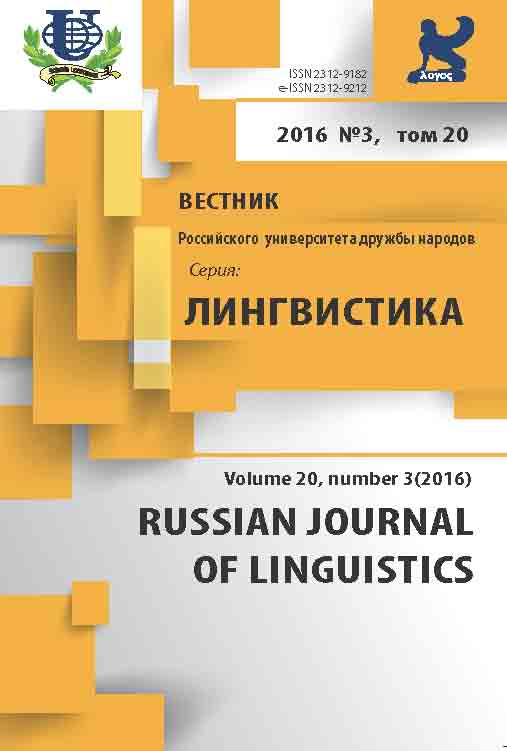Linguistic Representation of the Category of Oppositeness in English Folk Tales
- 作者: Solovyeva N.V.1
-
隶属关系:
- Moscow Region State University
- 期: 卷 20, 编号 3 (2016)
- 页面: 77-88
- 栏目: Articles
- URL: https://journals.rudn.ru/linguistics/article/view/14741
如何引用文章
全文:
详细
The purpose of the article is to study manifestations of the category of oppositeness at all language levels in order to establish a classification of textual oppositions found in folktales. Achieving this goal requires using integrated multi-disciplinary research methods such as hypothetical-deductive, inductive, descriptive, comparative and classification methods. The study also involves specifically linguistic research procedures: the method of phonological oppositions which served as the methodological basis for further research into morphological and grammatical oppositions, transformational and component analyses to describe the semantic content of the considered language units, the logical and semantic procedures in text analysis. English is used as the basis for the research, the theoretical principles are illustrated by the data included in The Oxford Dictionary of Synonyms and Antonyms, The Merriam-Webster Dictionary of Synonyms and Antonyms, and The Collins Dictionary of Synonyms and Antonyms, the collection of folktales edited by J. Jacobs serves as the material for the empirical analysis. The category of oppositeness is seen as a phenomenon represented by phonological, semantic and grammatical oppositions and their subclasses. The textual oppositions under consideration are based on semantic and grammatical oppositions and represent the opposed spatial images, the opposed characters and the opposed beginning and ending of a folktale. The phenomenon of neutralization, which is the removal of the opposition in certain positions, is found at all levels of the language system, manifesting itself on the textual level in the ambivalent nature and the contradictory functional roles of certain folktale characters.
作者简介
Nataliya Solovyeva
Moscow Region State University
Email: natavs@list.ru
Perevedenovsky Side-Street, 5/7, 105082, Moscow, Russia
参考
- Akhmanova, O.S. (2015, October 4). Slovar' lingvisticheskikh terminov [The dictionary of linguistic terms]. Retrieved from: http://www.classes.ru/grammar/174.Akhmanova (In Russian)
- Apresyan, Yu.D. (1974). Leksicheskaya semantika. Sinonimicheskie sredstva yazyka [Lexical Semantics. Synonymous means of the language]. Moscow: Nauka. (In Russian)
- Boeva, N.B. (2013). Grammaticheskaya antonimiya v sovremennom angliiskom yazyke [Grammatical antonymy in modern English]. Moscow: MPGU
- English Fairy Tales collected by J. Jacobs. (2015). Moscow: KnigapoTrebovaniyu
- Jakobson, R. Selected writings. I:Phonological studies. (3rd ed.). Berlin, New York: Mouton de Gruyter
- Jeffries, L. (2010). Opposition in Discourse:The Construction of Oppositional Meaning. London: Continuum International Publishing
- Justeson, J.S., Katz S.M. (1992). Redefining antonymy: The textual structure of a semantic relation. Literary and Linguistic Computing, 7, 176-184
- Levi-Strauss, C. (1983). The Raw and the Cooked. Mithologiques. Vol. 1. Chicago: University of Chicago Press
- Saeed, J.I. (2003). Semantics. Oxford: Blackwell Publishing Ltd
- Stefanenko, T.G. (1999). Ehtnopsikhologiya [Ethno psychology]. Moscow: Institut psikhologii RAN, «Akademicheskii Proekt». (In Russian)
- The Concise Oxford Dictionary of Linguistics. (2007), 2nd (ed.). Oxford: Oxford University Press
- Trubetzkoy, N.S. (1969). Principles of phonology. Berkeley: University of California Press














